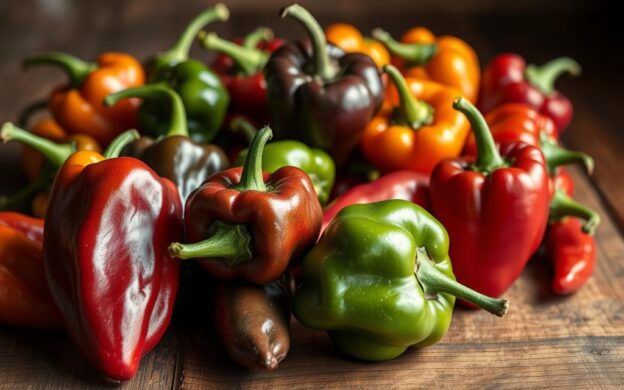Habanero peppers are a captivating culinary gem, renowned for their fiery heat and vibrant flavor. Originating from the Yucatán region of Mexico, these small, bright orange or red habanero peppers have captured the hearts of spice enthusiasts worldwide. In this article, we’ll explore the origins, history, and diverse culinary uses of habaneros, as well as delve into their unique flavor profiles and the potential health benefits of habaneros.
From their Scoville heat scale to their distinct characteristics, you’ll discover why habaneros have earned their place as one of the most sought-after chili peppers in the world. Whether you’re a passionate home cook or a professional chef, this exploration of the fiery realm of habanero peppers is sure to inspire and delight your culinary senses.
The Origins and History of Habanero Peppers
The fiery habanero peppers have a rich and captivating history, tracing their origins to the Yucatán Peninsula in Mexico. These spicy chili peppers have been an integral part of Mesoamerican cuisine for centuries, with evidence of their cultivation dating back to the Mayan civilization. The name “habanero” is derived from the city of Havana, Cuba, where the peppers were once a popular trade item.
Tracing the Spicy Roots of the Habanero
Over time, habaneros have become deeply woven into the culinary traditions of various Latin American countries. From their use in signature salsas and marinades to their role in ceremonial and ritual dishes, these peppers have played a significant cultural role in the region. The history of habanero peppers is a testament to the enduring legacy of Mesoamerican cuisine and the resilience of its flavors.
Cultural Significance of Habaneros in Culinary Traditions
The origin of habanero peppers can be traced back to the Yucatán Peninsula, where they have been cultivated for centuries. These fiery chili peppers have become a staple ingredient in Mexican cuisine, adding a unique and bold flavor to a variety of dishes. The cultural significance of habaneros in culinary traditions is a testament to the rich history and diversity of Latin American gastronomy.
Unleashing the Heat: Habanero Scoville Scale and Flavor Profile
Habanero peppers are renowned for their intense heat, which is measured on the Scoville scale. Typically ranging from 100,000 to 350,000 Scoville heat units, habaneros are considered one of the hottest chili peppers in the world. This intense spiciness is what draws many people to the habanero, as they seek out the thrill of the heat.
However, the heat levels of habaneros can vary depending on factors such as growing conditions, cultivation methods, and individual pepper varieties. Some habanero cultivars may even reach the upper limits of the Scoville scale, approaching the realm of the world’s hottest peppers.
Beyond their fiery nature, habaneros also possess a unique and complex habanero flavor profile that includes fruity, floral, and slightly smoky notes. This balance of heat and flavor is what makes habaneros a versatile ingredient in both savory and sweet dishes, allowing them to add a delightful punch of spiciness of habanero peppers to a wide variety of culinary creations.
Whether you’re a seasoned chili enthusiast or a newcomer to the world of habanero scoville scale, the habanero’s captivating combination of heat and flavor is sure to leave a lasting impression on your taste buds.
Habanero Cultivation and Growing Tips
Growing habanero peppers can be a rewarding and exciting endeavor for home gardeners and commercial producers alike. These peppers thrive in warm, tropical climates and require specific growing conditions to reach their full potential. From selecting the right soil and planting techniques to managing pests and diseases, mastering the art of habanero cultivation can be a delicate balance.
Mastering the Art of Growing Habaneros
When it comes to cultivating habanero peppers, attention to detail is key. Gardeners should focus on providing the optimal soil conditions, including well-draining soil rich in organic matter. Proper spacing and staking are also essential to support the plants as they grow. Regular watering and consistent fertilization can help ensure healthy, productive habanero plants.
Overcoming Challenges in Habanero Cultivation
While growing habaneros can be immensely rewarding, there are also challenges that growers must navigate. Pests like aphids, spider mites, and pepper weevils can be problematic, requiring vigilant monitoring and the use of organic pest control methods. Disease management, such as addressing issues like bacterial spot or fungal infections, is also crucial for successful habanero cultivation.
